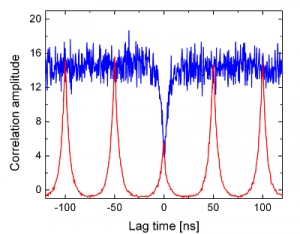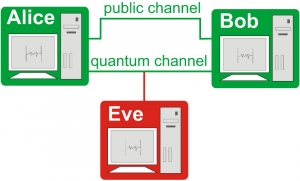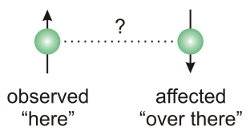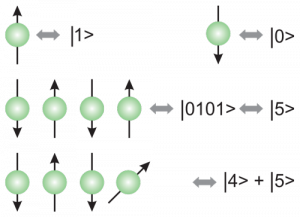Quantum optics is a field of research that deals with the application of quantum mechanics to phenomena involving light and its interactions with matter. One of the main goals is to understand the quantum nature of information and to learn how to formulate, manipulate, and process it using physical systems that operate on quantum mechanical principles.
Determine the presence of a single quantum system
Coincidence correlation with picosecond timing can be used to determine if one is actually observing a single quantum system in the form of a single photon emitter. Here one employs the knowledge that such a system can only emit one photon at a time. This is because in typical quantum systems such as single molecules or defect centers in diamond there is a characteristic average lifetime of the excited state that must pass before the system can be excited again. If one finds that two detectors observing the source „click“ simultaneously (with statistical significance) then obviously the source cannot be a single photon emitter.
In case of experiments dealing with photon entanglement (example for coincidence counting of entangled photons) one effectively tries to prove or disprove correlations between measurement outcomes using some kind of correlator. In the case of experiments with photons one may, for instance, employ polarizers to filter out quantum states of interest and then use photon detectors to determine whether or not they occurred correspondingly at both parts of the entangled pair. Now, given that photon detectors are not 100% efficient (and actually neither is the creation of entangled pairs and their transmission) one typically must repeat the experiment many times in order to arrive at a statistically reliable answer. Since there can also be unwanted photons from background radiation or detector artifacts it is a smart common practice to perform the coincidence correlation with picosecond timing. The correlations can then be determined for narrow time windows where the knowledge of the time the photons travel can be used to eliminate background.
Read More

Quantum mechanics guarantee secure communication
Quantum communication is a field of applied quantum physics closely related to quantum information processing and quantum teleportation. Its most interesting application is protecting information channels against eavesdropping by means of quantum cryptography. The most well known and developed application of quantum cryptography is quantum key distribution (QKD). QKD describes the use of quantum mechanical effects to perform cryptographic tasks or to break cryptographic systems. The principle of operation of a QKD system is quite straightforward: two parties (Alice and Bob) use single photons that are randomly polarized to states representing ones and zeroes to transmit a series of random number sequences that are used as keys in cryptographic communications. Both stations are linked together with a quantum channel and a classical channel. Alice generates a random stream of qubits that are sent over the quantum channel. Upon reception of the stream Bob and Alice — using the classical channel — perform classical operations to check if an eavesdroper has tried to extract information on the qubits stream. The presence of an eavesdropper is revealed by the imperfect correlation between the two lists of bits obtained after the transmission of qubits between the emitter and the receiver. One important component of virtually all proper encryption schemes is true randomnessm which can elegantly be generated by means of quantum optics.
Read More

A common quantum mechanical state of separated systems
Quantum entanglement is a physical phenomenon that occurs when quantum systems such as photons, electrons, atoms or molecules interact and then become separated, so that they subsequently share a common quantum mechanical state. Even when a pair of such entangled particles are far apart, they remain "connected" in the sense that a measurement on one of them instantly reveals the corresponding aspect of the quantum state of its twin partner. These "aspects" of quantum state can be position, momentum, spin, polarization, etc. While it can only be described as a superposition with indefinite value for the entangled pair, the measurement on one of the partners produces a definite value that instantly also determines the corresponding value of the other. The surprising "remote connection" between the partners and their instantaneous action "faster than light" that would seem to contradict relativity has been the reason for intense research efforts, both theoretically and experimentally. In the corresponding experiments, entanglement is proven by correlation of the measurment outcomes on the separated twins.
Read More

A qubit transmitted from one location to another
Quantum teleportation is closely related to entanglement of quantum systems. It may be defined as a process by which a qubit (the basic unit of quantum information) can be transmitted from one location to another, without the qubit actually being transmitted through space. It is useful for quantum information processing and quantum communication. As with entanglement, it is applicable to simple and more complex quantum systems such as atoms and molecules. Recent research demonstrated quantum teleportation between atomic systems over long distances.
Read More
Quantum Information Processing focuses on information processing and computing based on quantum mechanics. While current digital computers encode data in binary digits (bits), quantum computers aren't limited to two states. They encode information as quantum bits, or qubits, which can exist in superposition. Qubits can be implemented with atoms, ions, photons or electrons and suitable control devices that work together to act as computer memory and a processor. Because a quantum computer can contain these multiple states simultaneously, they provide an inherent parallelism. This will enable them to solve certain problems much faster than any classical computer using the best currently known algorithms, like integer factorization or the simulation of quantum many-body systems. Right now the quantum computer is still in its infancy. First steps on that road are the simplest building blocks such as quantum logic gates and memory based on genuine quantum effects such as superposition and entanglement.
Read More
